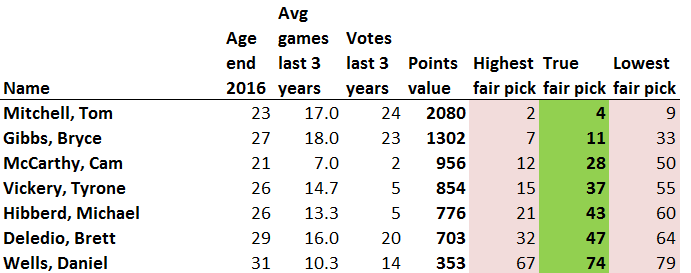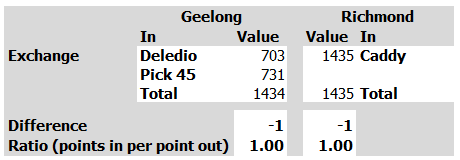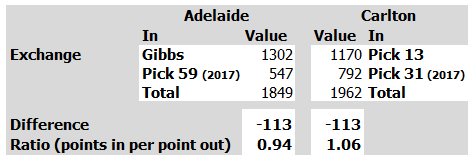Everyone makes mistakes, right? Forgetting your best mate’s name, taking the wrong turn and ending up in Bundanoon, ordering a beer and ending up with a mid-strength impersonation of a beer.
Everyone makes mistakes. But we’ve made one that renders part of our previous two day of coverage to be incorrect. At HPN we believe in full transparency, so we will now detail exactly how we stuffed up, and the corrected information.
Rather embarrassingly, HPN noticed last night that our player value calculations so far had not been referencing 2016 data for games and Brownlow votes, instead referencing the three year window of 2013-15 for estimates of future output. We model future output based on rolling three-year samples so this has impacted on a few of the player values we’ve published so far.
Most of the values are roughly the same, however two are radically different: Tom Mitchell and Brett Deledio. Gibbs and Hibberd have marginally different values, with the former becoming more valuable and the latter less.
The error did not impact at all on the one actual trade to have occurred so far, since Cam McCarthy played zero AFL games in both 2013 and 2016.
Below is the updated values of everyone HPN has discussed, including the two free agency compensation assessments we tweeted about. We’ll comment below on where those estimates have changed the assessment significantly.

Tom Mitchell is actually very valuable
We thought a trade of 14 for Mitchell would be slight unders but basically fair, based on an estimate of future output excluding his stellar 2016. Mitchell has played 17 games a year for 3 years and received 24 Brownlow votes in that time. This significantly improves his value from 1437 points (around pick 9) to 2080 points (around pick 4). The following would be considered a very fair trade with Hawthorn’s available picks:

Hawthorn might also consider substituting a 2017 pick for one of these two picks, depending on the details of the O’Meara trade.
Deledio is worth even less
Our discussion around Brett Deledio centred around his age and recent spotty durability. That still holds, but our estimate is now a bit lower. Rather than pick 35 with an upper bound of around pick 14, we now get pick 47 with an upper bound of pick 32.
This would probably feel to Richmond like gross unders, but if we’re comparing future output from Deledio to the typical whole career of a pick, that’s where it sits.
The key question here is expected retirement age – we assume a retirement age for an elite player like Deledio of 32.4 years. Career length is the overriding variable determining the value of a player who turns 30 next year. The HPN formula uses 32.4 as an estimate based on the average retirement age of All-Australians across the last few years. If Deledio is expected, for whatever reason, to last longer than that, his output obviously goes up compared to our estimate. A retirement age assumption of 35 years would make him worth somewhere around pick 14.
Geelong’s second round pick (the first they have available) looks like it might be around the mark.

With reports Josh Caddy might have been requested by Richmond we can also look at that. Caddy has a substantially longer career ahead of him, and more to give a club. He averages 17.7 games a season, and at 24 should have around two thirds of his career output ahead of him.
By our reckoning, Deledio and pick 45 for Caddy would be a very well-balanced deal in terms of expected future output:

With Geelong believing they’re in the hunt for a flag they will likely be thinking short term with this trade, and Richmond will be demanding a lot for a much-loved player. Don’t be surprised if, according to our output-based valuation system, the Cats happily pay substantially over the odds for Deledio. This remains a fascinating one to watch.
Gibbs is worth a little bit more, but not much
We rated Gibbs worth pick 14 initially while noting that in the context of a highly valued former number one pick, under contract, Adelaide will be expected to pay more. That still largely holds. With Gibbs rated at being worth around pick 11, here’s how an offer of pick 13 looks:

It’s theoretically fair, but again, in context, Carlton will want more. Our suggested alternative is still reasonably balanced, depending on what each club thinks about the other’s 2017 prospects.

How to view Hibberd’s year off?
We mentioned in discussing Michael Hibberd that he’d missed a year of footy due to his suspension.
What we missed was that our valuation, based on three years of footy he did play, actually probably approximated what he would have been worth without that forced layoff. We valued him based on barely missing a game from 2013 to 2015. To recap that, we thought Melbourne’s pick 28 was probably a little under the mark:

However, if we add in Hibberd’s zero-match season we get the following:
 With Hibberd assumed to have less future output (13 games a season rather than 20), Essendon look like getting a good deal. In all honesty, we do not know how clubs might be viewing the forced absence. Does it increase the risk that a player won’t get back to form? Perhaps. Will Hibberd go straight back to playing virtually every game as a reliable defensive cog? Who knows?
With Hibberd assumed to have less future output (13 games a season rather than 20), Essendon look like getting a good deal. In all honesty, we do not know how clubs might be viewing the forced absence. Does it increase the risk that a player won’t get back to form? Perhaps. Will Hibberd go straight back to playing virtually every game as a reliable defensive cog? Who knows?
All we can do here is present the two scenarios. We can note that a player serving a year-long anti-doping infraction presents a curly output projection dilemma, and suggest that pick 28 might end up being close enough.

Why would you use Browlow votes and not something with less margin for error and less biased towards midfielders? Only 3 votes are given a game. I would have thought something with a higher distribution of votes would be a better indicator of player value.
Hi, thanks for the question.
We also use AA selections as a fall-back to apply an equivalent loading. The two methods produce different loadings, and the higher is used.
The loading is designed to produce a ceiling around 60% or 70% based on reasoning you can read here – http://hurlingpeoplenow.tumblr.com/post/99609672717/how-important-is-an-elite-footballer
It’s 1% per Brownlow vote over the last 3 years, or 20% per AA selection in that time and 10% for squad.
For example Alex Rance has a 60% loading due to three AA selections but a far lower Brownlow weighting. Dangerfield on the other hand currently gets 78% via Brownlow.
Largely the reason we use these two is it’s relatively little work and we’re not sure any other indicator captures defenders well anyway. If we added another method (say, Supercoach ratings or something multifactor based on possessions, goals, time on ground, whatever) it would be as an additional method not a replacement.
Hi Sean,
Many thanks for your work here. I’ve only recently come across this blog – it makes for really good reading.
Slightly off topic, but I’m wondering whether you’ve done any statistical work on the connection b/w draft position and career outcomes i.e. something that might provide a sense of how useful draft position is as a predictor of a player’s ultimate quality. If you have a look at previous drafts, it’s surprising how many relatively high picks end up not amounting to much. It’d be interesting to assess the prospects for success for (say) picks 10-20 compared to picks 30-50, based on past experience.
p.s. to Lamby’s point, I feel like supercoach ratings (or some such) is a better indicator of value than either Brownlow votes or AA nomination/selection – not that i mean to tell you how to do your job!
Hi Paul,
Two posts that might be of interest to you:
https://hurlingpeoplenow.wordpress.com/2016/10/10/the-hpn-draft-pick-trade-value-chart-v2-0/
This contains a plot of the raw data behind our pick values – basically average career games per pick modified by Brownlow votes.
https://hurlingpeoplenow.wordpress.com/2016/08/05/round-20-the-survival-function-of-afl-draftees-and-ports-makeshift-ruck/
This one presents “survival functions” for pick ranges – the proportion who make it to X number of games.
Thanks Sean. I can see now that the analysis i was asking after informs the trade values you’ve generated.
It does look like the Swans have been short-changed in the Tom Mitchell deal, particularly given the reports that Hawthorn have gotten pick 10 from St Kilda. I’m not sure why they didn’t hold out a little.